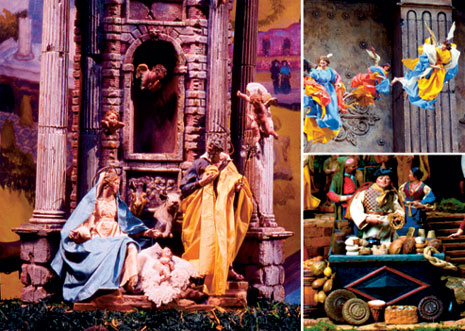Back

Italian, Neapolitan Presepio,
1700-1830, Carnegie Museum of Art, Gift of Mr. and Mrs.
George Wyckoff
Derived from the Latin word praesepium, which means manger
or stable, and based on events at the heart of Christianity,
presepi were extremely popular between the 16th and 18th
centuries, eventually becoming not only one of the showiest
expressions of Italian Christian faithfulness, but also
status symbols for the noble, aristocratic, and middle
classes in Naples, Italy.
“
Between the 14th and 16th centuries, Bethlehem—the
site of the Nativity—was a very popular pilgrimage
site, and royal families returning from their trips spread
interest in and devotion to the Nativity throughout Italy,” says
Elisabeth Agro, assistant curator of decorative arts at
Carnegie Museum of Art. “They also paid to have elaborate
presepi built in churches or chapels. Then, around the
turn of the 18th century, the aristocracy brought the presepio
out of the church and into the home and its popularity
really began to flourish.”
While every presepio ever
made included three scenes based on Christian Gospels—the
inn that denied the travelers space, the Holy Family in
a manger, and the angels’ visit
to the shepherds—at the height of its popularity
in the 18th century, the presepio had very little to do
with religion. Over time, the elaborate scene around the
Nativity evolved and began to depict contemporary Neapolitan
life. It became a popular pastime among the aristocracy
to decorate the figures in the latest fashions using expensive
fabrics and even jewels, displaying them in a different
way every holiday season. In fact, constructing and visiting
presepi in private homes became an important social ritual.
“
The presepi in 18th-century Naples were a way of displaying
a family’s wealth, social status, and artistic
sensibilities,” Agro says. “
The size, richness, and complexity of the owner’s
display determined the owner’s level of prestige.”
By
the middle of the 19th century, interest in presepi making
and collecting waned and most of the important private
collections were separated, either sold off in pieces or
placed in museums. Purchased in 1956, Carnegie Museum of
Art’s Presepio is one of just a few antique Neapolitan
presepi in the United States that is still remounted every
year. The entire collection consists of 123 handcrafted
figures and animals and more than 100 accessories, props,
and architectural elements.
“
The Presepio at Carnegie Museum of Art is one of the best
examples of its kind outside of Italy,” says Agro. “It’s
a very rare and exceptional artifact, and we’re pleased
that we have been able to share this important Italian
holiday tradition with Pittsburghers for the last 48 years.”
This year, visit the Neapolitan Presepio in its new location
in the Hall of Sculpture at Carnegie Museum of Art. It
will be on view through January 8. Guided tours of the
Presepio will be offered Tuesdays through Sundays, November
25 through December 31, from 12:30-1 p.m.
Back
| Top |